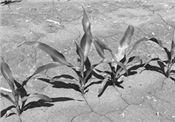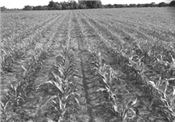Stunted Corn Following Prevented Planting – Fallow Syndrome
GREGORY A. LUCE
COLUMBIA, MO.
There are many corn fields in Missouri, in particular the NE portion of the state, where corn is stunted and uneven following prevented planting acres. Many farmers, extension and industry agronomists and consultants are working with fields that are showing dramatically poorer corn growth in prevented planting vs fields following a crop in 2015. In a number of cases there are side by side comparisons where soybean or a cover crop was planted in same field last year that had portions unplanted. The answer commonly given to explain the poorer growth behind prevented planting has been the effect of what is known as Fallow Syndrome. In some cases the answers involve multiple factors, and there are fields where not all of the stunted corn growth may be attributed to Fallow Syndrome. However, there are many fields in the NE counties, where Fallow Corn Syndrome appears to be the predominant cause. The degree of stunted corn varies greatly and factors such as field drainage, nitrogen management, manure application, the previous season weed cover and the phosphorus soil test levels all may have a part in the range of severity.
What is Fallow Syndrome?
Fallow syndrome got the name from cropping systems in the dry plains states where they routinely benefited from the additional soil moisture available after the previous year had been summer fallowed. However, corn sometimes suffered from lack of phosphorus uptake and stunted growth when planted following the fallow period. Symptoms may include purple coloration and short, uneven and weak plants. Low soil phosphorus and/or cold and wet soils could certainly magnify the situation.
Fallow Syndrome is a result of population reduction of a particular fungi (vesicular arbuscular mycorrhizae or VAM) due to no plants growing in that field the previous year. The mycorrhizal fungi has a symbiotic relationship with corn and small grains. The mycorrhizae develop around the corn roots and assist the root in taking up nutrients, primarily P and Zn. The mycorrhizae benefit by accessing the sugars from the root system of the host plant. As plants grow out of the phosphorus deficient symptoms they have remained pale and stunted in the most impacted fields.
Most agricultural crops have mycorrhizae, and so do most weeds, but not all benefit equally from the symbiosis, and not all are equally as good of a host. For instance, Brassica crops are not a host. Corn happens to be particularly dependent on mycorrhizae.
Observations by many field representatives also indicate that corn grown on prevented planting acres, where there was weed coverage or small grain cover crops seeded last fall, displays better corn growth than where nothing grew in 2015. As previously mentioned, Brassicas are not hosts for the mycorrhizae. Forage radish and turnips are Brassica family members, and where Brassicas were seeded on prevent plant acres, reports are that there is stunted corn with fallow syndrome type symptoms.
There are many examples of remarkably enhanced corn growth where corn followed soybeans or a grass cover crop directly adjacent to where corn followed prevented planting. The field in Figure 2 is an example of the many observations from across NE Missouri.
Why are we seeing so much problem this year? It is noted by many farmers and agronomists in Missouri that, although we expected major issues after the floods in the 1990s, we did not experience the extreme issues we have seen in 2016. Many close observers of corn in the Midwest have also indicated that fallow syndrome symptoms are more likely when the fallow occurs during wet, cool conditions. Here are a few thoughts on why we are seeing more issues this year:
• 2015 Extremes! The 2015 season was truly unique. Many growers that have farmed all their lives in NE Missouri could not ever remember a year like 2015. I had certainly never experienced a season where the extreme wet weather lasted so long that soybean planting did not occur on upland acres. Although we have seen flooding in bottoms that prohibited planting, fallow on such as large amount of upland acres was unprecedented.
• Drainage impact. Many of the most impacted corn fields, grown where the crop did not get planted last year, are flatter and more poorly drained. (That’s of course why they didn’t get planted in 2015). Although many of these fields have very good yield potential, they can be subject to early season stresses related to drainage which are more common on flat, claypan soils. I have observed that portions of problem fields, with somewhat better drainage, show significantly improved growth.
• Cold, wet conditions this spring is also a connection. Fields with the greatest issues are in areas that had significant wet periods and it was certainly very cold for a time this spring.
• Phosphorus content in the fields showing the most negative issues this year may be lower in soil test P. Bottomland fields often have higher P levels and, perhaps why the less than expected issues following the floods.
• Fields vary greatly in degree of stunting, and multiple factors could be involved. Don’t assume it is only one factor. Consider all the past management practices and field conditions while assessing the problem.
Impact of Soil Test Phosphorus Level?
Some research on Fallow Syndrome has shown a relationship to fallow having greater negative impact on lower testing soils. Dr. Manjula Nathan, Director of the University of Missouri Soil Testing and Plant Diagnostic Service Laboratories, did her Ph.D. work in South Dakota studying: the Effects of Mycorrhizal Colonization, Early Growth and Phosphorus Uptake of Corn. Her work, in a two year study, showed that fallow negatively impacted phosphorus uptake of corn and also showed reduced corn growth in a low Phosphorus test soil. However, on a high phosphorus testing soil the fallow did not have those negative effects. Dr. Nathan’s work also showed that corn following soybean, in the low P test soils, had greater P uptake and early growth than where corn followed fallow, barley or corn. Although mycorrhizal colonization explained some of the benefit to the previous soybean crop, other benefits from soybeans must have been involved. For example, mycorrhizal colonization was also very good following corn, as would be expected, but corn growth after soybean and P uptake after soybean in the low test field were significantly greater than corn following other crops. We know that there would be contribution of nitrogen from soybean, but corn benefits from a previous soybean crop in other respects that we are still trying to identify and understand.
Can the stunted corn be corrected in 2016? There are no proven recommendations for alleviating the poor corn growth following prevented planting acres but here are some thoughts and suggestions to consider:
• In order to recover stunted corn that is P deficient, broadcasting P will likely have minimal effect on rescuing Fallow Syndrome effected corn.
• There are old references from the 1960s showing some yield improvement by adding additional P close to the row and cultivating it in.
• If the soil is sealed a cultivation alone may aerate the soil and stimulate rooting and enhance plant growth.
• Knifing in additional Nitrogen could be beneficial to plant growth stimulation. If inadequate amounts of N have been applied to this point it would be most advantageous.
• Foliar P is a consideration, however, macronutrients like Phosphorus are not readily taken into the plant through the leaves and root uptake is needed for significant levels to be taken up by the corn plant.
What to do in the future? With this situation, certainly prevention is a key. When prevented planting occurs again, particularly on upland, claypan fields, here are some suggestions:
• Plant soybeans as long as you possibly can. Soybean has the potential to yield reasonably well when planted late and is a tremendous crop for corn to follow.
• If no crop is planted then plant a cover crop if at all possible. Grasses like cereal rye, wheat or oats would be good choices as would legumes. This would provide a host crop for the mycorrhizae and the earlier in the season, the better. Remember that Brassicas like turnip and radish are not hosts to mycorrhizae and if used after fallow they would need to be mixed with host type cover crops.
• Don’t skimp on phosphorus after fallow. If soil test levels are low a banded starter application of Phosphorus and Zinc would be more effective than broadcast applications.
• Soybeans are a good option to plant after prevent plant acres as they are not as susceptible to Fallow Syndrome.
• Typically the effects of Fallow Syndrome are not seen two years after the fallow period. ∆
GREGORY A. LUCE: Adjunct Instructor, Division of Plant Sciences, University of Missouri

Figure 1. Phosphorus deficient Corn plants –
a typical symptom associated with corn grown following fallow.

Figure 2. Corn in foreground followed soybean;
the smaller, pale corn is growing following no crop in 2015.